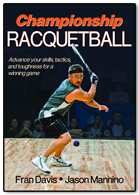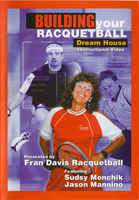 When you are good center court position, down and ready, you are on defense and your opponent who is hitting the ball is on offense. You have put yourself in the best possible position to get to whatever ball your opponent hits that is left up and getable. Remember good center-court position is located approximately in a 6-foot-by-6-foot area behind the dotted line because 80 to 90 percent of all balls that are hit wind up in the back half of the court. Therefore, center court is in the middle of the back half of the court. There are a few things you can do to get a quicker jump on the ball and anticipate the shot your opponent is about to take.
When you are good center court position, down and ready, you are on defense and your opponent who is hitting the ball is on offense. You have put yourself in the best possible position to get to whatever ball your opponent hits that is left up and getable. Remember good center-court position is located approximately in a 6-foot-by-6-foot area behind the dotted line because 80 to 90 percent of all balls that are hit wind up in the back half of the court. Therefore, center court is in the middle of the back half of the court. There are a few things you can do to get a quicker jump on the ball and anticipate the shot your opponent is about to take.
Watch and Read the Ball and Your Opponent
- Look at the height, speed, and angle of the ball.
- Height: If the ball is high, your opponent is probably going up to the ceiling. If the ball is lower, your opponent is probably going to shoot either the pass, pass-kill, or kill, or maybe a pinch.
- Speed: If the ball is hit hard and fast, there is less time for racquet prep; therefore, your opponent will spray the ball and not be very consistent.
- Angle: If the ball is hit close to the side wall, there will be a lot of straight in and out shots or maybe a splat shot. If the ball is coming off a side wall, it will probably be hit back to that same side wall. Also, when you hit a ball to your opponent, they are most likely to hit the ball back at the same angle as the ball coming in to them. If you hit a crosscourt, your opponent is likely to hit a crosscourt back. If you hit a down the line, they will likely hit a down the line back. It is more difficult to change the ball’s angle, and therefore a player is likely to take the easy route.
Look at your opponent’s racquet and contact point.
- If the racquet is behind your opponent, expect a pinch or a splat.
- If the racquet is way out in front, expect a crosscourt shot.
- If the racquet is up above your opponent’s head on the forehand side, expect either a forehand ceiling ball or, if it drops a little, an overhead pass.
- Look at your opponent’s body position.
- Look at your opponent’s feet because players usually step in the direction they are going to hit the ball.
- If your opponent is standing straight up, expect a higher shot that ends up deeper in the court.
- If your opponent is low, expect a lower shot such as the kill or pinch shot that ends up in the front of the court.
Analyze Your Opponent
- Know what level of player you are facing and what shots they are capable of making. If they cannot hit a wide-angle pass or a splat shot or an overhead pass, you don’t need to worry about covering those shots; instead, focus on the shots they make more often because most players are predictable.
- Be aware of your opponent’s patterns. Look at each position they are shooting from, and determine whether they hit only one shot from each position. Do this exercise all over the court. Take mental notes of what your opponent does in different situations.
- Look at the habits your opponent possesses, such as an exaggerated backhand grip that will force a lot of high-to-low balls, or a pendulum swing that lofts the ball high in a lot of instances, or a tendency to crowd or jam himself and then hit a lot of front wall or side wall shots for setups. Be alert at all times.
Too often we see players giving up on the ball prematurely—before it bounces twice—because they think they can’t get to it in time. We encourage you to go after everything. By watching and reading the ball and your opponent, you will get a better jump on the ball, and you will get to more balls than you ever thought you could.
Use the techniques in my book Championship Racquetball to understand the concept of “Center Court Position and What to Look for in Center Court” …. Chapter 5, page 149-150.
ALL of the players I coach, from the professionals led by Rocky and Paola to the amateurs, know just how important it is to learn “Center Court Position and What to Look for in Center Court”. It’s not easy to do, but a MUST. Rocky and Paola are BOTH 2 of the most decorated athletes in racquetball. Paola finished the 2015-2016 season ranked #1 on the LPRT for the 5th consecutive season and was crowned 4X World Champion, the Central American Champion and the 2X Pan American Champion. Also, now 6X UnitedHealthcare US Open Champion. Rocky finished the 2015-2016 IRT season ranked #2 on the men’s professional International Tour (IRT) and is 4X World Champion, 2X Pan American Champion and 1X US Open Champion.
In the next issue, I will continue to build your Championship Racquetball Game one level at a time so you too can be ready to become the champion you always dreamed of becoming, by giving you the tools to make it a reality. Rocky’s and all my athletes “Championship Racquetball Games” stem from their focus on ALL 3 sides of the triangle working together so they can develop into top competitors. Without a shadow of a doubt, they KNOW just how important it is to do the work. They are living proof it works and their titles substantiate it.
For details on more personalized instruction, a weekend camp, instructional DVD’s and tips in our book, Championship Racquetball, ALL which covers all aspects of the Sports Racquetball Triangle and more, please visit www.FranDavisRacquetball.com. Fran Davis is a 2004 racquetball Hall of Fame inductee; Racquetball Woman of the Year 2009; Coaches #2 IRT Pro Player / 1X US Open Champion / 4X and present World Champion, 2X Pan American Champion, Rocky Carson; Coaches #1 Women’s LPRT Pro Player / 6X and present US Open Champion & 4X World Champion, 2X Pan American Champion, Paola Longoria; Coaches Jr. World & National Champions, Jordan Cooperrider, Wayne Antone & Mitchell Turner; Master Professional Instructor/Coach USAR-IP.
![[:en]Fran11-11Banner750x300[:]](http://www.irt-tour.com/wp-content/uploads/2014/07/Fran11-11Banner750x300-300x132.jpg)










